Two weeks ago, we introduced Process+, a combination of PLV’s Decision Value, Contact, and Power metrics formatted into one holistic number. There’s a good chance you’ve already seen one of the graphs floating around Twitter/X, but consider this the formal introduction.
Process+ is built on PLV, or Pitch-Level Value, which was introduced last year to quantify individual pitches and their importance.
Seeing the prevalence of Stuff models in the public sphere, it’s easy to quickly find the underlying pitch metrics for any pitcher. “Stuff-ists” can effortlessly find the single number that defines a pitcher, for better or worse.
But that didn’t exist with hitters, at least until now. You can combine any sort of underlying stats: traditional plate discipline, Statcast batted ball data, or even PLV to get some semblance of an idea about a hitter. However, there’s no clear-cut formula for what to look for. With Process+, you can see all facets of a hitter conjoined into one—not a results-based stat, but an underlying one, showing how well one’s process is.
Consider it per-pitch “xwRC+”: who is creating the most runs with the aspects of hitting they have the most control over on each pitch? These aspects include swing decisions, contact ability, and exit velocity/launch angle, all relative to the quality of the pitches they’ve faced.
Process+ was created by Kyle Bland, Pitcher List’s Director of Analytics, as a continuation of PLV on the hitting side. I also want to thank Kyle for the immense help on this article.
How Does It Work?
If you aren’t familiar with PLV, here’s a quick refresher (though I recommend reading the full PLV intro article linked above). PLV is runs created over average in any situation. For example, hitting a 110mph line drive on a dotted fastball will create more runs above average than the same batted ball on a hanging curveball.
With the basis of PLV, we were able to create a handful of statistics. On the hitting side, Decision Value, Contact, and Power are three stats that comprehensively explain an individual hitter. Combining them all together yields Process+, which shows a hitter’s true underlying talent, similar to Stuff+ and Location+ for pitchers.
There isn’t a “secret sauce” weighting that creates Process+; rather, it’s the combination of runs generated from Decisions, Contact, and Power. Any run created from a Decision is the same as any run created from Power.
Runs generated from decisions (Decision Value) are implicitly small, but because a hitter needs to make a swing decision every pitch, that run value accrues quickly. Power, on the other hand, is the direct opposite: it only appears on batted balls but unsurprisingly has the largest impact on runs generated. Contact falls somewhere in the middle as it appears on all swings, coming into play on whiffs, foul balls, and batted balls.
The three metrics are explicitly designed to not have any interaction in results. Contract controls for the value of the Decision made and Power controls for the value of Contact on that swing. There may be some external interaction between Contact and Power, as different hitters have different swings designed to do specific things. Giancarlo Stanton isn’t swinging with his 100th percentile swing speed to achieve the same outcome as Luis Arraez. He’s trying to launch a 120mph home run into orbit. His skillset influences his Decisions, which in turn influences Contact and Power.
According to Kyle, one of Process+’s challenges is that it compares a hitter’s decisions and swings to “average” results, and there is a lot of swing diversity. None of the components are tailored to the specific hitter, so some individual nuance is lost for the benefit of cross-hitter comparisons.
Decisions and Contact become reliable at 400 pitches, while Power becomes reliable at 900 pitches since it needs batted ball events.
As I mentioned before, it is essentially expected wRC+ on a per-pitch basis. The main difference between Process+ and wRC+ is that wRC+ is solely results-based. wRC+ doesn’t account for the actual swing decisions themselves but rather what comes from them at the end of an at-bat. For example, a decision to take on 0-0 in an at-bat that ends at 2-2 does not get accounted for in wRC+ but does in Process+. This allows Process+ to encapsulate a more true process of a hitter since no pitch goes unnoticed.
The two have a strong relationship, but it’s not 1:1: there’s a statistically significant 0.59 r-squared relationship between the two.
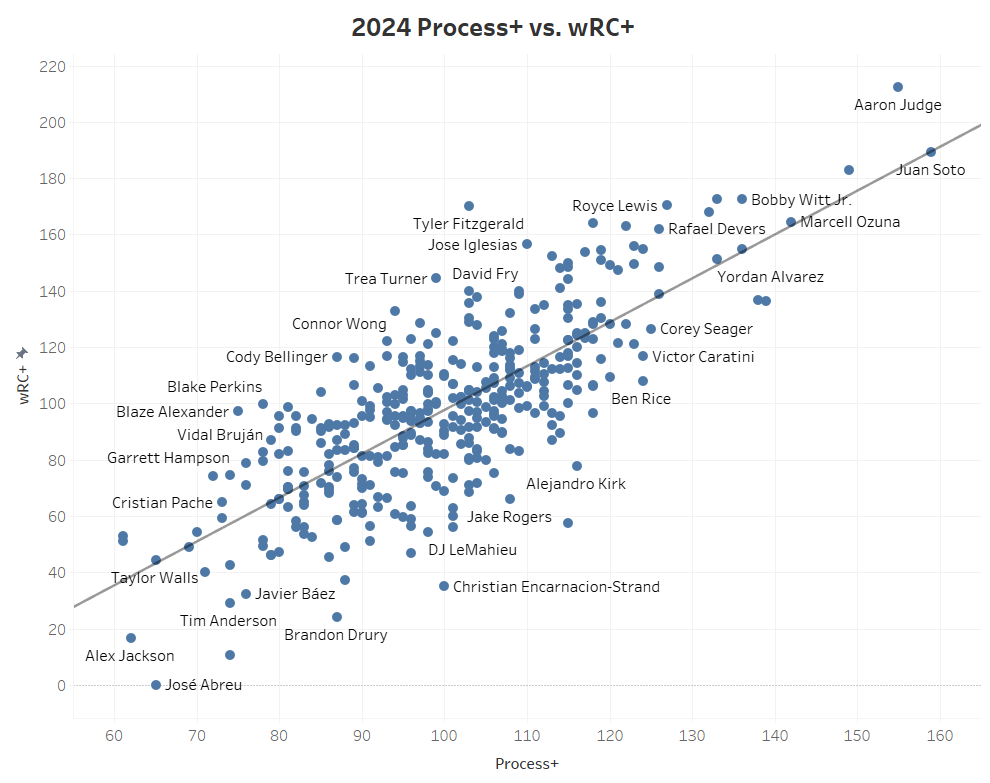
Not only is Process+ useful in season, but it can actually provide more value from season to season than wRC+. Looking at 2020-2023 data, Process+ has a 0.29 r-squared with next year’s wRC+, while wRC+ only has a 0.23 r-squared with next year’s wRC+.
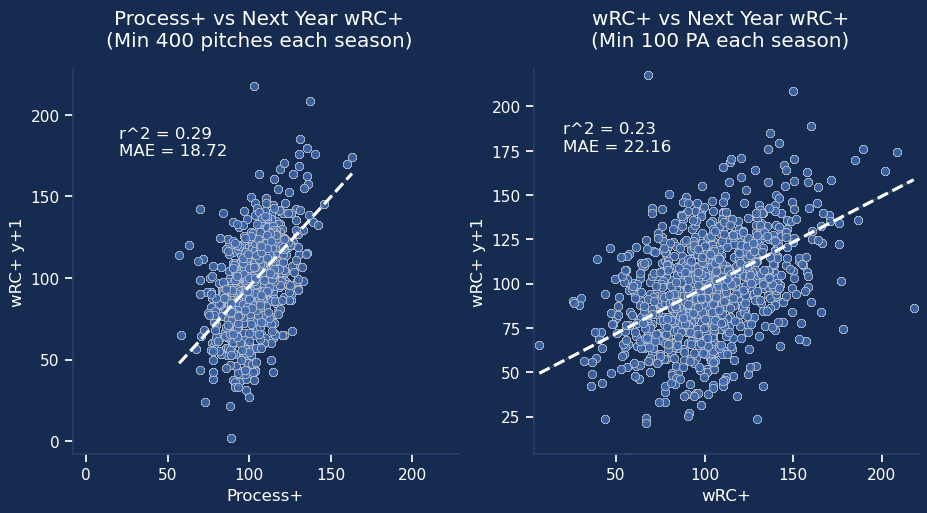
Within itself, Process+ is also sticky. It has a 0.45 r-squared correlation with next year’s Process+.
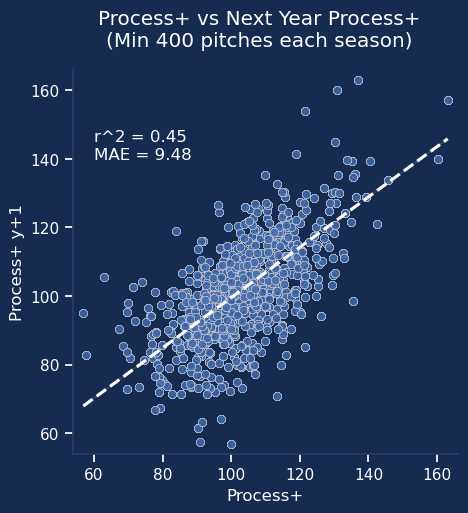
Now that we’ve discussed Process+’s background and usefulness, let’s examine the players and teams themselves.
What Does the League Landscape Look Like?
You will not be surprised when I tell you that Juan Soto leads baseball with a 159 Process+. Mixing elite decision-making and elite power with average contact results in the best hitter in baseball.
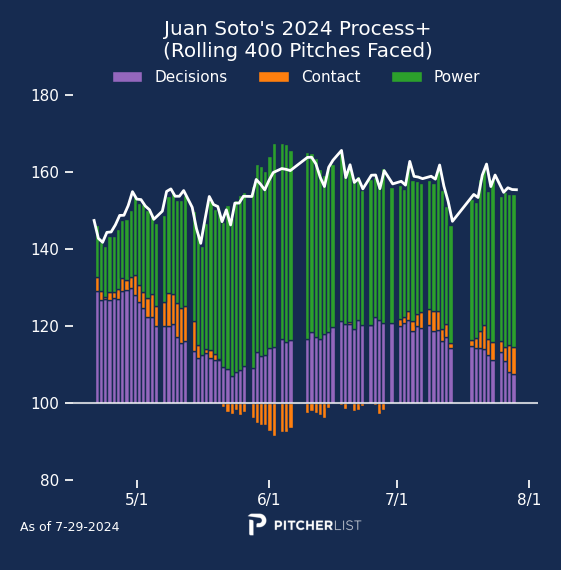
Soto is ever-so-slightly ahead of teammate Aaron Judge and his 155 Process+. Judge leverages contact and power numbers similar to Soto’s but lags slightly in contact ability.
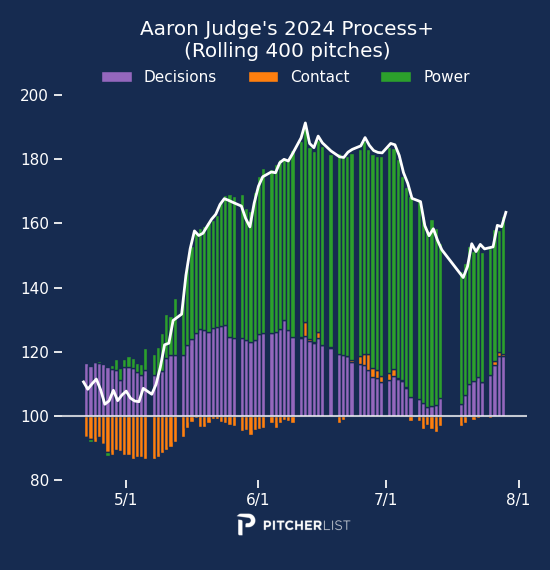
Going back to Soto, he is one of 22 hitters who are above average in all three components. These hitters range from Kyle Tucker and Ketel Marte to Patrick Bailey and Tommy Pham. While being good at everything is nice, it’s not the norm. I also believe one of the key points of Process+ is to identify hitters who achieve similar figures from different paths.
For example, let’s look at Xavier Edwards and Mark Vientos. They have around the same Process+ (118 vs. 117) but get there in completely different ways. Edwards is slashing .378/.453/.480 in 118 plate appearances, good for a gaudy 164 wRC+. He’s only hit 1 HR and runs a high BABIP, though has an exceptional 16.1% K% and 13.6% BB%. His Process+ tells a similar story: Edwards racks up most of his value through Decisions and some contact but yields negative Power.
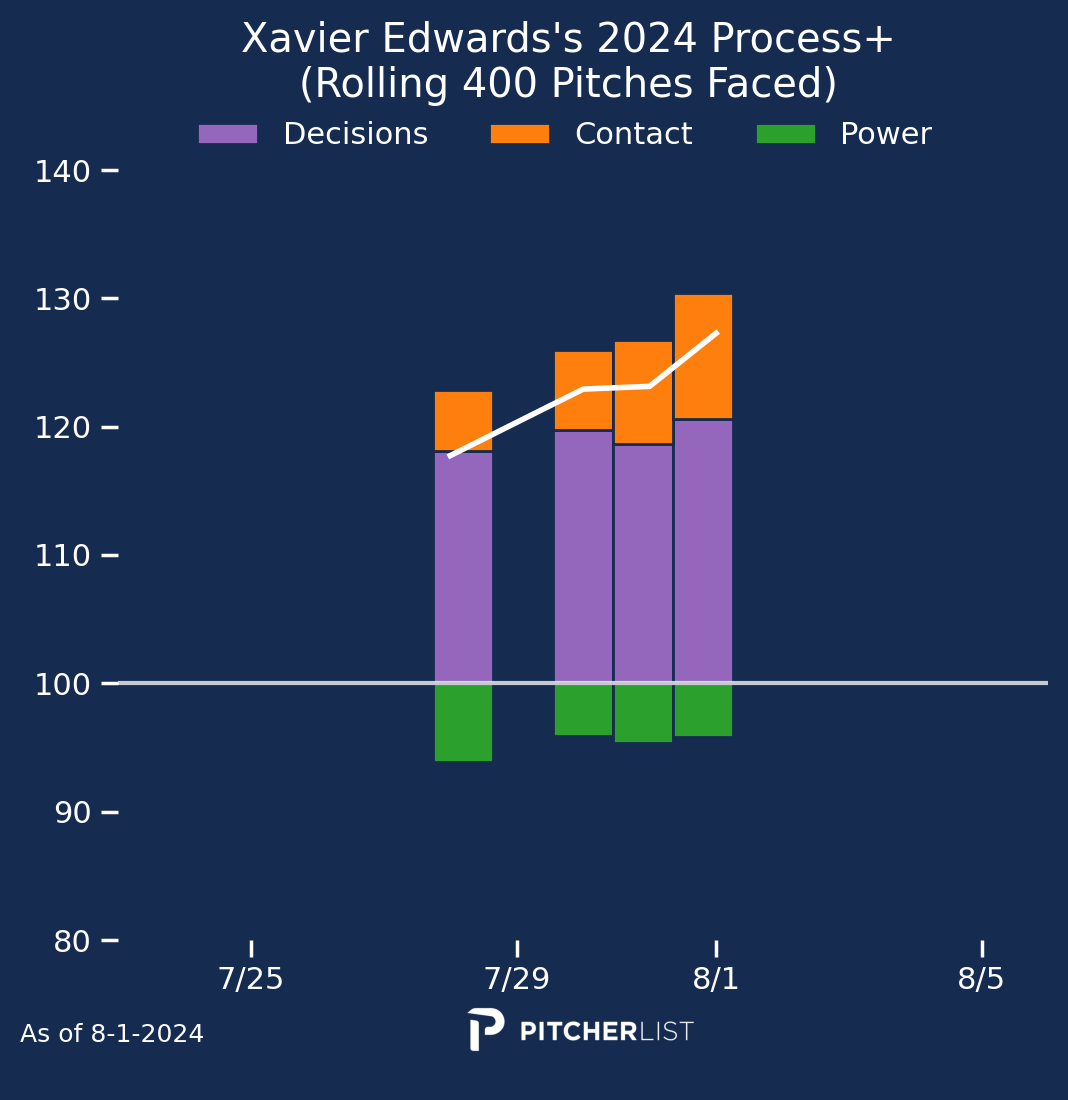
Mark Vientos is slashing .286/.341/.563 this year with a 26.0% K% and 7.7% BB%, getting to a 154 wRC+. Add in 16 HR in 246 plate appearances, and that’s a nice year for the Mets third baseman. His Power is the carrying tool in his approach, as the high strikeout rate suggests his Decisions and Contact aren’t phenomenal.
 Yet Vientos and Edwards are rated the same by Process+. Sure, they have different strengths that make them different hitters, but overall, they can be expected to create the same number of runs when they come up to the plate.
Yet Vientos and Edwards are rated the same by Process+. Sure, they have different strengths that make them different hitters, but overall, they can be expected to create the same number of runs when they come up to the plate.
On the other side, Pete Crow-Armstrong ranks last in Process+ with a 61. His underlying skills have been underwhelming, to say the least, and Process+ supports that, too.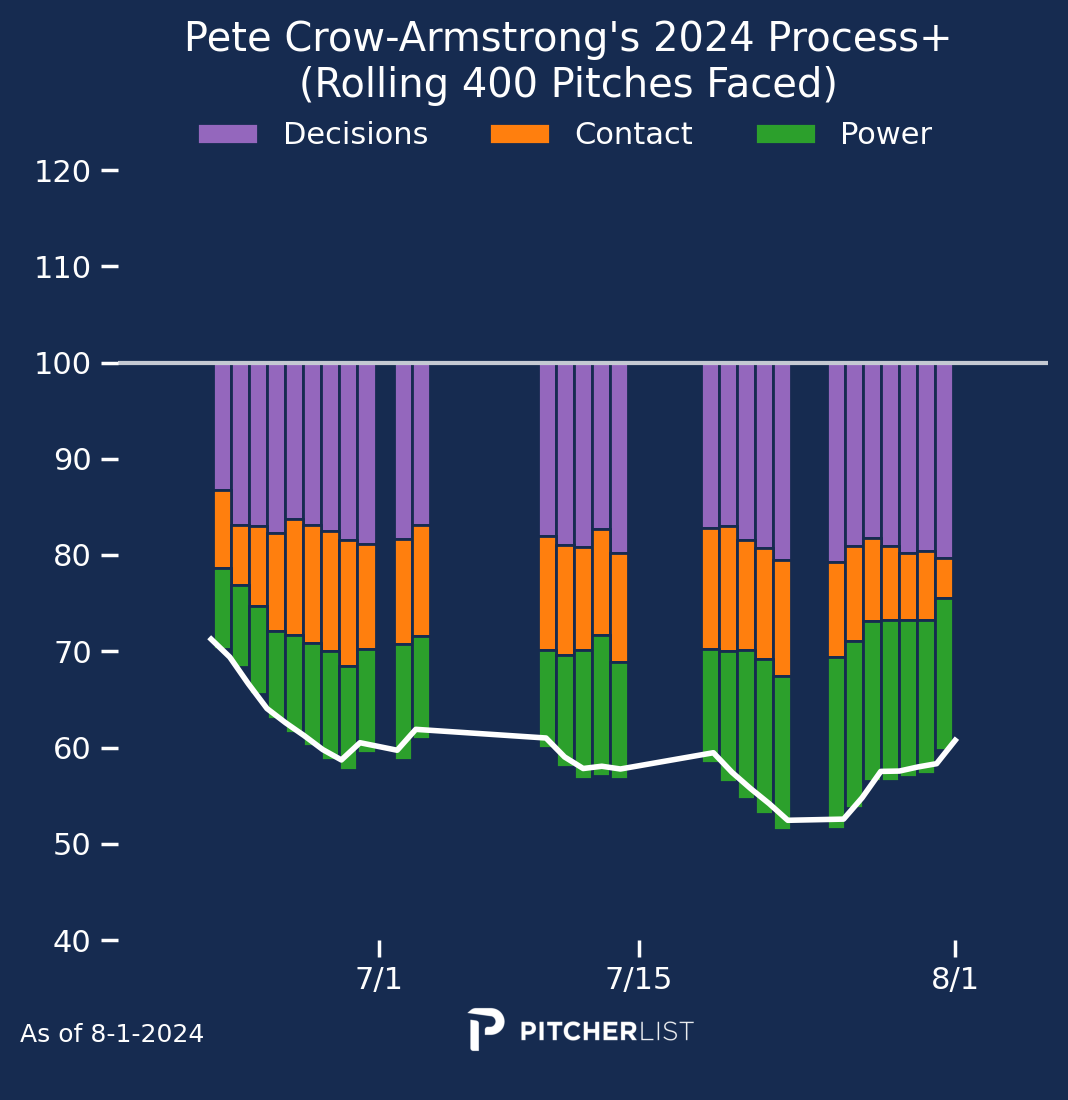
Within Process+, there can also be archetypes of one-tool players, like Brent Rooker. Rooker possesses a 132 Process+ built on the third-best power in baseball and below-average Decisions and Contact.
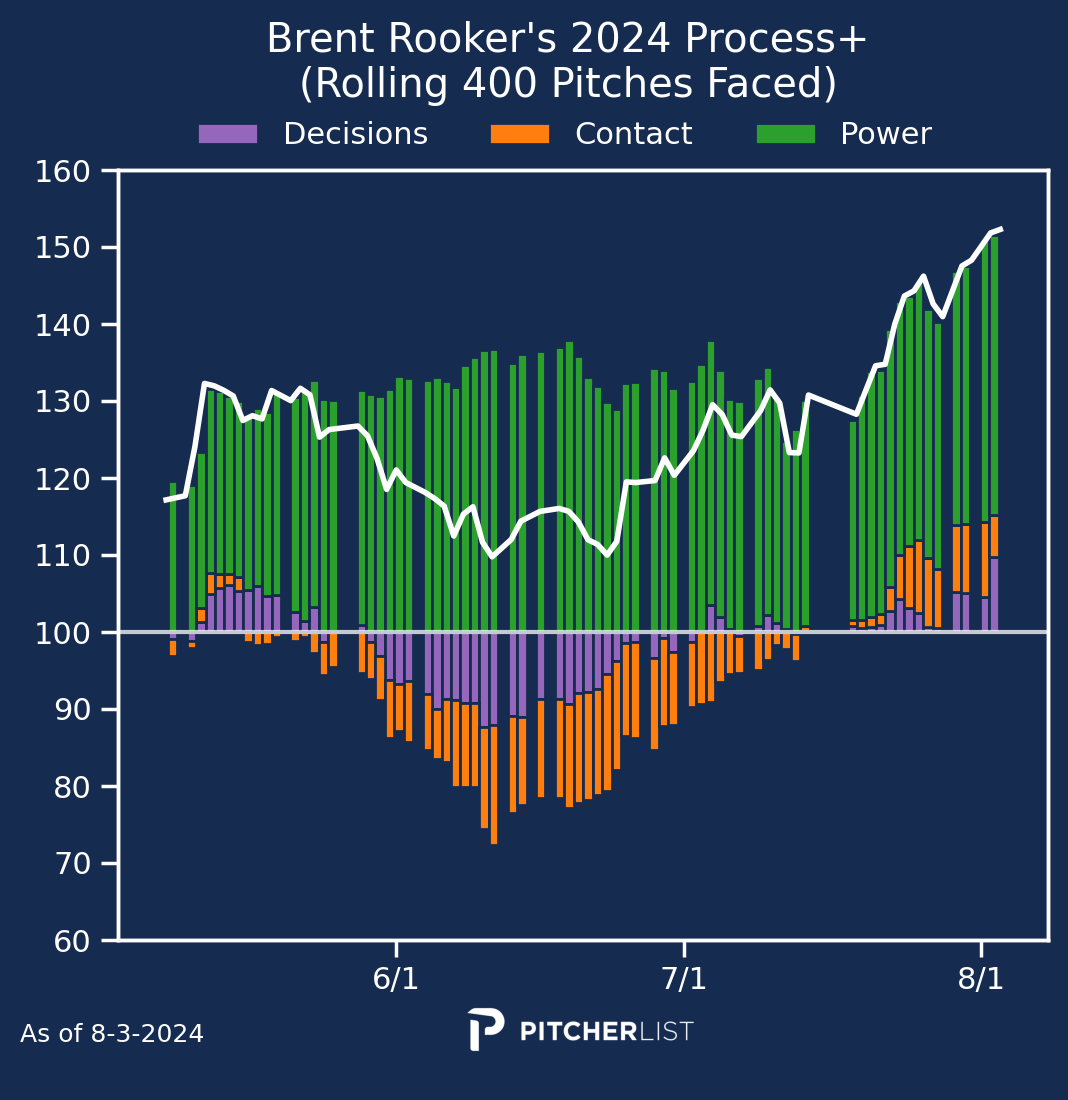
Though his Power has remained consistent, everything else has been highly volatile. He’s recently started making better Decisions and Contact, resulting in the second-best hitter in baseball since July 1 (only behind, of course, Juan Soto). Additionally, Rooker’s Process+ could be considered volatile itself: since Power takes the longest to stabilize, his Power has a better chance of not sticking at current levels.
Outside of season-wide totals, there’s some interesting data about who has changed the most in the last 400 pitches.
Most of these hitters have seen the biggest shifts due to changes in Power since a hot spell of HRs carries more weight in creating runs than anything else. But almost everyone on the riser and faller lists has changed all three aspects of their process; Power is just the biggest factor.
Now, moving onto team-wide statistics, the Yankees reign supreme with Soto and Judge, while the Reds sit in last place.
The Yankees and Dodgers make the best Decisions, which they pair with some of the best Power. The Padres make the second-best Contact (behind the Royals) with above-average Decisions and Power. The Reds, despite being in last place, make average Decisions but have poor Contact and Power.
One unique team is the Seattle Mariners, who make good Decisions and have good Power, but only have a 96 Process+. As you may have guessed, they make the worst Contact in baseball by a significant margin.
Going Forward
Process+ is a very powerful tool. It explains many of the results-based trends we see among hitters and is an exceptionally quick way to understand how a hitter will perform. Like Stuff models and PLV on the pitching side, it provides a glimpse into a player’s underlying approach, something every analyst and fantasy player wants to know.
With this stat out in the wild, more analysis will continue to show how Process+ is an effective tool and tells a story about a hitter.




Is there a website where you can do your own research for players? Like being able to plug in any name to see for ourselves? Or is this an inside league proprietary tool?
Hey James!
We offer Process+ for our PL Pro subscribers – it’s located inside the Nav menu at the top. Our Hitting Rolling Charts feature Process+ as an option where you can create all of these awesome charts yourself (with many more charts!)
Here’s a look at all our premium research tools with PL Pro – https://i.imgur.com/IvyLGX6.png